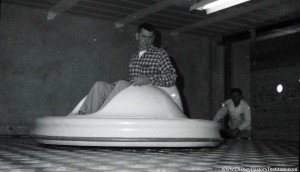 |
| Ed Morgan at the Arrow Test Facilities in Mountain View, California |
Flying Saucers at Disneyland
by Todd James Pierce
The four people most responsible for the creation and development of theme park culture in the 1950s and 1960s would be (in my opinion) Walt Disney, C.V. Wood, Nat Winecoff and Admiral Joe Fowler. Together, they largely oversaw the development of Disneyland, Freedomland, Pleasure Island, Six Flags over Texas, early work on Walt Disney World and to a lesser extent Pacific Ocean Park and many exhibits at the New York World’s Fair. Their work combined traditional outdoor amusement experiences with a cinematic sensibility—often with a historic or educational slant. Along with these park developers, there are two other engineers equally important to the creation of early theme park culture. They are the co-founders of the ride design company, Arrow Development—Ed Morgan and Karl Bacon.
Up on the blog today is a historical video on the development of the Flying Saucers attraction at Disneyland. The ride grew out of two concepts that WED explored in the late 1950s and early 1960s: the first, a water bumper boats ride called Duck Bumps; the second, a German hovercraft that WED tested at the studio. The hovercraft was a single seat fitted onto a disc, propelled by rotating blades. The bumper boat ride was probably too common to be used at Disneyland, as many amusement parks had bumper boats, while the German hovercraft with its rotating blades was simply too dangerous. Walt took these two ideas—the bumper boats and the hovercraft—to Ed Morgan and Karl Bacon (of Arrow) and asked them to develop a system that would combine aspects of these two rides into a single attraction.
By 1960, Arrow had developed ride systems for many early Disney attractions, including the ride-and-lift system for Dumbo, the ride system for the teacups, and the track and vehicles for Toad and Snow White. As Disneyland developed, Arrow engineered new ride experiences into existence: they created the first two-story dark ride system (Alice in Wonderland), and most importantly, they invented the tubular steel track-and-ride system for the Matterhorn. The ethos at Arrow wasn’t simply inventive; it was adaptive. Morgan and Bacon pursued ride systems to enhance storytelling environments. For example, with the Matterhorn, Morgan and Bacon weren’t developing a ride for speed or turn force; they were looking for a ride system that would approximate the experience of sledding. With that, they developed a roller coaster that used polyurethane wheels and tube rails to simulate the experience of gliding over banks of snow.
Today’s video showcases Arrow’s efforts with the Flying Saucers—a hovering bumper car ride first developed for Disneyland. Enjoy!
If you’re new to our side, make sure to check out these other videos on the history of Disneyland.
That’s all I’ve got for today. Post up your comments and questions below. I’ll be back in a couple weeks with a new post.
(edit: One more thing–if you’d like to know more about Ed Morgan and Karl Bacon, make sure to check out this book-length interview with them: Roller Coasters, Flumes, and Flying Saucers. For years it was out-of-print, but it has just been re-released as a $3 kindle edition.)

Recent Comments